Attracting tourists to your destination requires a compelling website. SIXT.VN understands that your website serves as the digital storefront for potential travelers, influencing their decision to visit Vietnam. We specialize in creating exceptional tourism web designs tailored to the unique needs of the travel industry, maximizing user engagement and driving bookings. With effective website design, you can increase booking conversion rate, enhance brand image, and improve user satisfaction.
1. Why is Best Tourism Web Design Important for Attracting International Visitors?
Best Tourism Web Design is important for attracting international visitors because it creates a strong first impression, builds trust, and provides an easy way to access information. A well-designed website serves as a virtual gateway to your destination, and SIXT.VN ensures that it is visually appealing, informative, and user-friendly.
- First Impressions Matter: Your website is often the first interaction potential tourists have with your destination. A professional and visually appealing design can immediately capture their attention and generate interest.
- Building Trust and Credibility: A well-designed website signals professionalism and reliability. Clear contact information, testimonials, and security badges can help build trust with potential visitors.
- Easy Access to Information: Visitors should be able to easily find the information they need, such as attractions, accommodations, transportation, and activities. Intuitive navigation and a clear site structure are essential.
- Mobile Responsiveness: A responsive design ensures that the website functions seamlessly on all devices, including smartphones and tablets, which are commonly used by travelers on the go. According to research from Statista in 2023, mobile devices account for approximately 60% of global web traffic, highlighting the importance of mobile optimization.
- Showcasing Visual Appeal: High-quality images and videos can effectively showcase the beauty and attractions of your destination, enticing visitors to explore further.
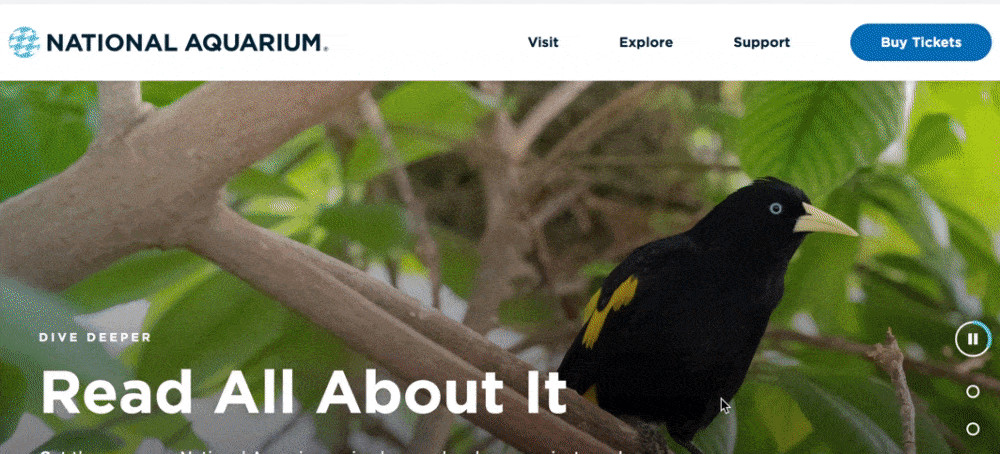 National Aquarium website with modern design
National Aquarium website with modern design
2. What Key Elements Should Be Included in a Tourism Web Design to Improve User Engagement?
Key elements to improve user engagement include high-quality visuals, clear navigation, mobile responsiveness, interactive features, and multilingual support. SIXT.VN prioritizes these elements to keep visitors interested and informed.
- High-Quality Visuals: Use stunning images and videos to showcase the beauty and attractions of your destination. Visual content is more engaging than text and can quickly capture visitors’ attention.
- Clear and Intuitive Navigation: Ensure that your website is easy to navigate with a clear menu structure and logical organization of content. Visitors should be able to find the information they need quickly and easily.
- Mobile Responsiveness: Design your website to be fully responsive, ensuring that it looks and functions perfectly on all devices, including smartphones and tablets.
- Interactive Features: Incorporate interactive elements such as maps, virtual tours, and interactive quizzes to enhance user engagement and provide a more immersive experience.
- Multilingual Support: Offer your website in multiple languages to cater to international visitors. Providing content in their native language can significantly improve their experience.
- Fast Loading Speed: Optimize your website for fast loading speeds to prevent visitors from getting frustrated and leaving. According to Google, 53% of mobile users abandon a site if it takes longer than three seconds to load.
- Compelling Content: Create informative and engaging content that provides value to visitors. This includes destination guides, travel tips, local insights, and event calendars.
3. How Does SIXT.VN Ensure Its Tourism Web Designs Are SEO-Friendly?
SIXT.VN ensures its tourism web designs are SEO-friendly by conducting thorough keyword research, optimizing website content, ensuring mobile-friendliness, and building high-quality backlinks. This helps improve search engine rankings and attract more organic traffic.
- Keyword Research: Identify relevant keywords that potential tourists are likely to use when searching for information about your destination.
- Content Optimization: Create high-quality, informative content that incorporates target keywords naturally. Optimize page titles, meta descriptions, and header tags to improve search engine visibility.
- Mobile-Friendliness: Ensure that your website is fully responsive and provides a seamless experience on all devices. Mobile-friendly websites tend to rank higher in search results.
- Site Structure: Create a clear and logical site structure that is easy for search engines to crawl and index.
- Link Building: Build high-quality backlinks from reputable websites in the travel industry. Backlinks are a key ranking factor for search engines.
- Schema Markup: Implement schema markup to provide search engines with more context about your website content, improving its visibility in search results.
- Image Optimization: Optimize images by compressing them to reduce file size and adding descriptive alt tags. This improves website loading speed and provides search engines with more information about the images.
4. What Are the Benefits of Integrating Social Media into Tourism Web Design?
Integrating social media offers several benefits, including increased brand awareness, enhanced engagement, direct communication with visitors, and improved website traffic. SIXT.VN helps businesses leverage social media to enhance their online presence.
- Increased Brand Awareness: Social media integration allows you to reach a wider audience and increase awareness of your destination.
- Enhanced Engagement: Social media provides a platform for direct interaction with potential visitors, allowing you to answer their questions, address their concerns, and build relationships.
- Direct Communication: Social media enables you to communicate directly with visitors, providing them with real-time updates, promotions, and event information.
- User-Generated Content: Encourage visitors to share their experiences on social media using a specific hashtag. User-generated content can serve as authentic testimonials and inspire others to visit your destination.
- Website Traffic: Social media integration can drive traffic to your website by including links to your website in social media posts and profiles.
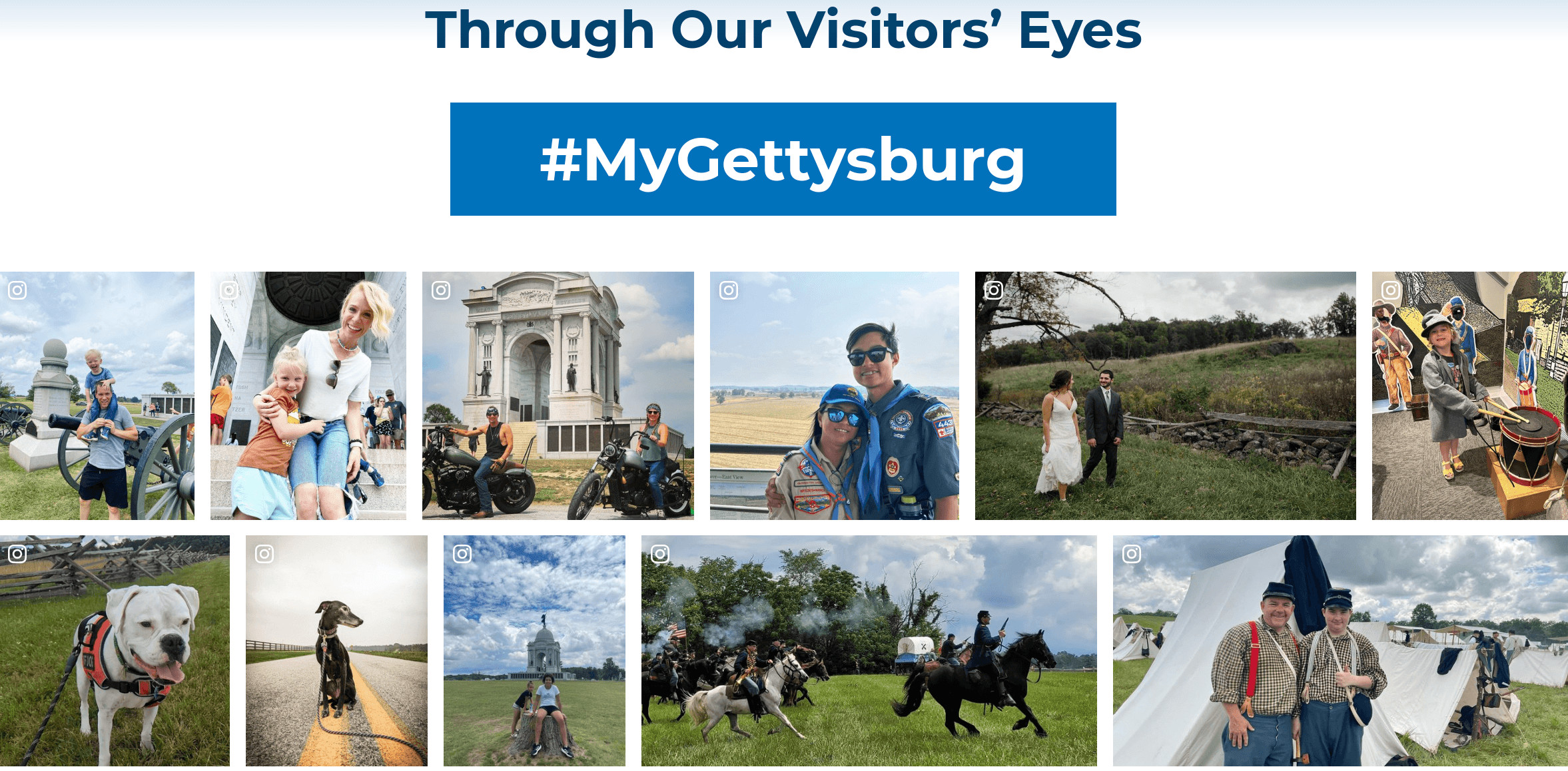 Instagram photos featured on Gettysburg
Instagram photos featured on Gettysburg
5. How Can a Tourism Website Incorporate Interactive Maps and Virtual Tours?
Tourism websites can incorporate interactive maps and virtual tours to enhance user engagement and provide a more immersive experience. Interactive maps allow visitors to explore different areas of your destination, while virtual tours provide a realistic preview of attractions and accommodations.
- Interactive Maps: Integrate interactive maps that allow visitors to zoom in on specific areas, view points of interest, and get directions.
- Virtual Tours: Create virtual tours of popular attractions, accommodations, and landmarks. Virtual tours can give visitors a realistic sense of what to expect when they visit.
- Geolocation Features: Use geolocation features to provide visitors with location-based recommendations and information.
- Integration with Mapping Services: Integrate your website with popular mapping services like Google Maps to provide visitors with seamless navigation and information.
6. What Role Does Mobile Responsiveness Play in Best Tourism Web Design?
Mobile responsiveness is essential in best tourism web design because a significant portion of travelers use mobile devices to research and book their trips. A responsive website ensures a seamless experience on all devices, enhancing user satisfaction and improving search engine rankings.
- Increased Mobile Usage: Mobile devices are increasingly used by travelers to research and book their trips. According to research from Condor Ferries in 2023, approximately 70% of travelers use their smartphones to plan their vacations, underscoring the critical need for mobile-optimized websites.
- Improved User Experience: A responsive website provides a seamless experience on all devices, enhancing user satisfaction and reducing bounce rates.
- SEO Benefits: Search engines prioritize mobile-friendly websites in search results, so a responsive design can improve your website’s ranking.
- Accessibility: A responsive website ensures that your content is accessible to all users, regardless of the device they are using.
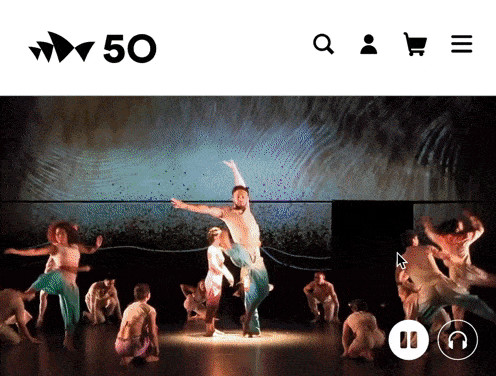 Scrolling through the mobile version of the Sydney Opera House website
Scrolling through the mobile version of the Sydney Opera House website
7. What Are the Best Practices for Using High-Quality Images on a Tourism Website?
Best practices for using high-quality images include using professional-grade photos, optimizing images for web use, adding descriptive alt tags, and ensuring images are relevant to the content. SIXT.VN focuses on optimizing visuals to enhance user engagement.
- Professional-Grade Photos: Use high-resolution, professional-grade photos that showcase the beauty and attractions of your destination.
- Image Optimization: Optimize images for web use by compressing them to reduce file size without sacrificing quality. This improves website loading speed.
- Descriptive Alt Tags: Add descriptive alt tags to all images to provide search engines with more information about the images. Alt tags also improve accessibility for users with visual impairments.
- Relevance: Ensure that all images are relevant to the content and provide value to visitors.
- Variety: Use a variety of images, including landscapes, attractions, activities, and people, to provide a comprehensive representation of your destination.
- Copyright: Ensure that you have the rights to use all images on your website. Use licensed stock photos or original photography.
8. How Can a Tourism Website Incorporate Customer Reviews and Testimonials Effectively?
Customer reviews and testimonials can be incorporated effectively by displaying them prominently, ensuring authenticity, providing a variety of reviews, and allowing visitors to submit their own feedback. SIXT.VN integrates these elements to build trust and credibility.
- Prominent Display: Display customer reviews and testimonials prominently on your website, such as on the homepage, product pages, and dedicated review pages.
- Authenticity: Ensure that reviews and testimonials are authentic and come from real customers. Consider using a third-party review platform to ensure credibility.
- Variety: Provide a variety of reviews that reflect different aspects of your destination and appeal to a wide range of visitors.
- Submission Options: Allow visitors to submit their own reviews and testimonials directly on your website.
- Response to Feedback: Respond to both positive and negative feedback in a timely and professional manner. This shows that you value customer opinions and are committed to providing excellent service.
 Scrolling feature with reviews from patrons who visited Dollywood
Scrolling feature with reviews from patrons who visited Dollywood
9. What Strategies Can Be Used to Improve Website Loading Speed for Tourism Websites?
Strategies to improve website loading speed include optimizing images, using browser caching, minimizing HTTP requests, using a content delivery network (CDN), and choosing a fast web hosting provider. SIXT.VN employs these strategies to ensure optimal performance.
- Image Optimization: Compress images to reduce file size without sacrificing quality. Use tools like TinyPNG or ImageOptim to optimize images.
- Browser Caching: Enable browser caching to store frequently accessed resources on the user’s device, reducing the need to download them repeatedly.
- Minimize HTTP Requests: Reduce the number of HTTP requests by combining CSS and JavaScript files, using CSS sprites, and avoiding unnecessary plugins.
- Content Delivery Network (CDN): Use a CDN to distribute your website’s content across multiple servers, reducing the distance between the server and the user.
- Web Hosting: Choose a fast and reliable web hosting provider that offers optimized servers and caching solutions.
- Code Optimization: Optimize your website’s code by removing unnecessary characters and comments, minifying CSS and JavaScript files, and using efficient coding practices.
10. How Can a Tourism Website Be Designed to Cater to International Audiences?
A tourism website can cater to international audiences by offering multilingual support, providing localized content, accepting multiple currencies, and ensuring cultural sensitivity. SIXT.VN helps businesses create inclusive and globally accessible websites.
- Multilingual Support: Offer your website in multiple languages to cater to international visitors. Provide a language selector that allows users to choose their preferred language.
- Localized Content: Provide localized content that is tailored to the specific interests and needs of different international audiences.
- Currency Options: Accept multiple currencies to make it easy for international visitors to book and pay for services.
- Cultural Sensitivity: Ensure that your website is culturally sensitive and avoids any content or imagery that may be offensive to international audiences.
- Address Formats: Use address formats that are appropriate for different countries.
- Time Zones: Display time zones correctly to avoid confusion when booking services or attending events.
- Mobile Optimization: Ensure that your website is mobile-friendly, as many international visitors use mobile devices to access the internet.
11. What Role Does Website Accessibility Play in Best Tourism Web Design?
Website accessibility is essential in best tourism web design because it ensures that people with disabilities can access and use your website. Accessible websites are not only ethical but also improve user experience and expand your potential audience.
- Inclusivity: Ensure that your website is accessible to people with disabilities, including visual, auditory, motor, and cognitive impairments.
- Compliance: Comply with accessibility standards such as the Web Content Accessibility Guidelines (WCAG).
- Improved User Experience: Accessible websites are easier to use for all users, not just those with disabilities.
- SEO Benefits: Search engines favor accessible websites, so improving accessibility can also improve your website’s ranking.
- Legal Requirements: In some countries, website accessibility is required by law.
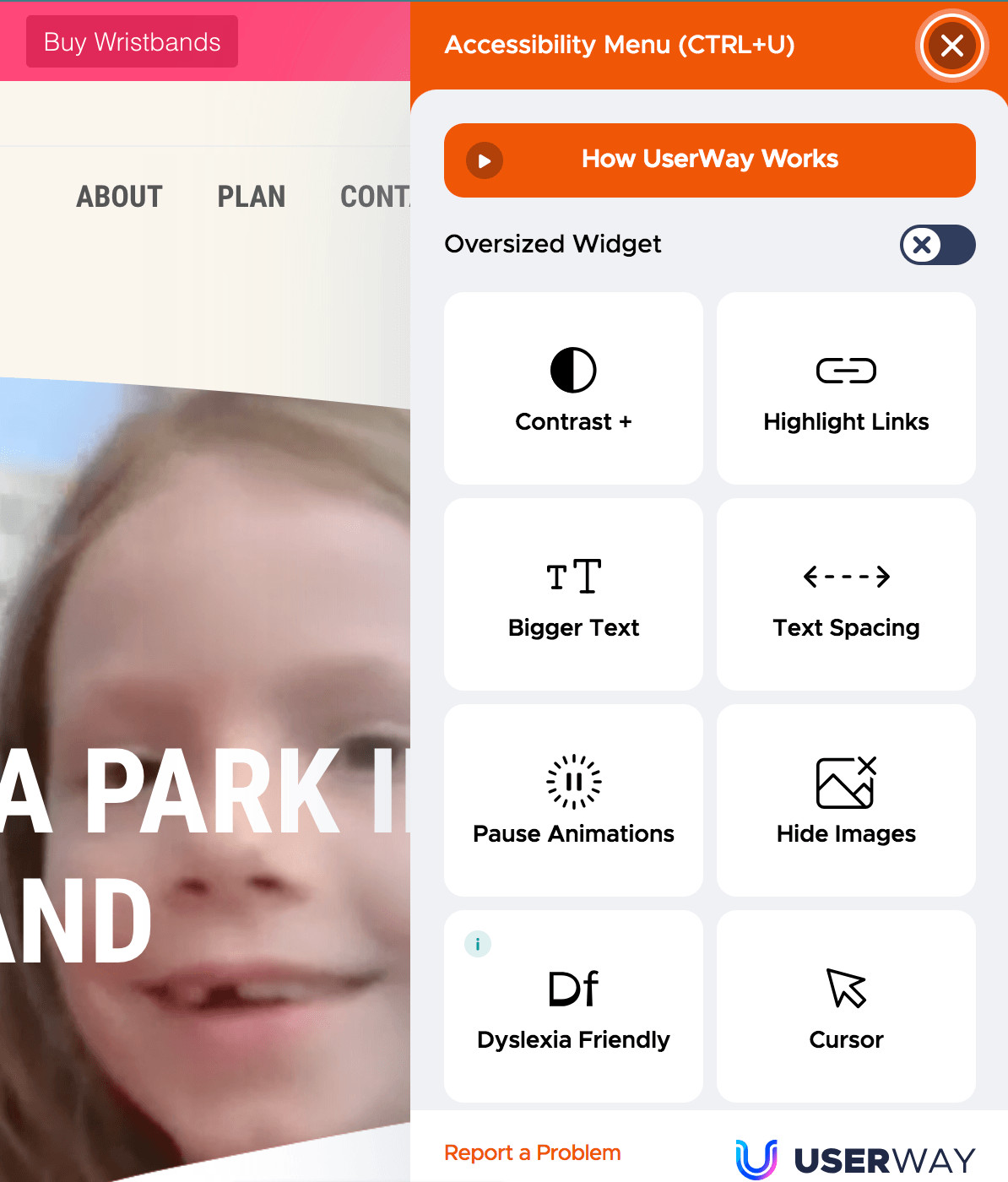 Accessibility menu bar on Luna Park
Accessibility menu bar on Luna Park
12. What Are the Best Practices for Call-to-Action (CTA) Buttons in Tourism Web Design?
Best practices for call-to-action (CTA) buttons include using clear and concise language, making them visually prominent, placing them strategically, and creating a sense of urgency. SIXT.VN optimizes CTAs to drive conversions and encourage visitors to take desired actions.
- Clear and Concise Language: Use clear and concise language that tells visitors exactly what will happen when they click the button. Examples include “Book Now,” “Learn More,” and “Get a Quote.”
- Visual Prominence: Make CTA buttons visually prominent by using contrasting colors, bold fonts, and ample white space.
- Strategic Placement: Place CTA buttons strategically throughout your website, such as on the homepage, product pages, and blog posts.
- Sense of Urgency: Create a sense of urgency by using language that encourages visitors to take action immediately. Examples include “Limited Time Offer” and “Book Now Before It’s Too Late.”
- Mobile Optimization: Ensure that CTA buttons are easy to tap on mobile devices.
 Orange call to action button with the text
Orange call to action button with the text
13. How Can Tourism Web Design Incorporate Local Events and Festivals?
Tourism web design can incorporate local events and festivals by creating an events calendar, featuring event details prominently, integrating social media, and partnering with local organizations. SIXT.VN helps businesses promote local events to attract more visitors.
- Events Calendar: Create an events calendar that lists all upcoming local events and festivals.
- Detailed Information: Provide detailed information about each event, including dates, times, locations, and ticket prices.
- Social Media Integration: Integrate social media to promote events and encourage visitors to share their experiences.
- Partnerships: Partner with local organizations to promote events and cross-promote your website.
- Visuals: Use high-quality images and videos to showcase events and festivals.
14. What Are the Key Considerations for Website Navigation in Tourism Web Design?
Key considerations for website navigation include creating a clear and intuitive menu structure, using descriptive labels, providing a search bar, and ensuring mobile-friendliness. SIXT.VN focuses on optimizing navigation to ensure a seamless user experience.
- Clear Menu Structure: Create a clear and intuitive menu structure that is easy for visitors to understand.
- Descriptive Labels: Use descriptive labels that accurately reflect the content of each page.
- Search Bar: Provide a search bar that allows visitors to quickly find the information they need.
- Mobile-Friendliness: Ensure that your website navigation is mobile-friendly and easy to use on small screens.
- Breadcrumbs: Use breadcrumbs to help visitors understand their location within the website.
- Footer Navigation: Include important links in the footer of your website, such as contact information, privacy policy, and terms of service.
15. How Can Tourism Web Design Showcase the Unique Culture and Heritage of a Destination?
Tourism web design can showcase the unique culture and heritage of a destination by using authentic imagery, incorporating local stories, promoting cultural events, and partnering with local artisans. SIXT.VN helps businesses highlight their local culture to attract visitors.
- Authentic Imagery: Use authentic imagery that reflects the unique culture and heritage of your destination.
- Local Stories: Incorporate local stories and legends into your website content.
- Cultural Events: Promote cultural events and festivals that showcase the traditions and customs of your destination.
- Local Artisans: Partner with local artisans to sell their products on your website or promote their businesses.
- Historical Information: Provide historical information about your destination, including its origins, significant events, and cultural influences.
- Testimonials: Share testimonials from visitors who have experienced the culture and heritage of your destination.
16. What Is the Importance of White Space in Tourism Web Design?
White space, also known as negative space, is the empty space around elements on a webpage. It is important in tourism web design because it improves readability, reduces clutter, and focuses attention on key elements.
- Improved Readability: White space improves readability by making it easier for visitors to scan and digest content.
- Reduced Clutter: White space reduces clutter by creating a clean and uncluttered design.
- Focus Attention: White space focuses attention on key elements, such as images, headings, and CTA buttons.
- Aesthetic Appeal: White space creates a sense of balance and harmony, improving the overall aesthetic appeal of your website.
 Scrolling through the French Quarter website with white space on the edges
Scrolling through the French Quarter website with white space on the edges
17. How Can Tourism Web Design Integrate Video Content Effectively?
Tourism web design can integrate video content effectively by using high-quality videos, embedding videos strategically, optimizing videos for web use, and adding captions and transcripts. SIXT.VN helps businesses leverage video content to engage visitors and promote their destination.
- High-Quality Videos: Use high-quality videos that showcase the beauty and attractions of your destination.
- Strategic Placement: Embed videos strategically throughout your website, such as on the homepage, product pages, and blog posts.
- Optimization: Optimize videos for web use by compressing them to reduce file size without sacrificing quality.
- Captions and Transcripts: Add captions and transcripts to make your videos accessible to people with disabilities and those who prefer to read along.
- Call to Action: Include a call to action at the end of your videos to encourage visitors to take the next step.
- Video SEO: Optimize your videos for search engines by adding descriptive titles, descriptions, and tags.
18. What Are the Key Elements of a Successful Landing Page for a Tourism Website?
Key elements of a successful landing page include a clear headline, compelling visuals, a concise description, a strong call to action, and social proof. SIXT.VN optimizes landing pages to drive conversions and encourage visitors to take desired actions.
- Clear Headline: Use a clear and concise headline that tells visitors exactly what the page is about.
- Compelling Visuals: Use compelling visuals that showcase the beauty and attractions of your destination.
- Concise Description: Provide a concise description that highlights the key benefits of your offering.
- Strong Call to Action: Use a strong call to action that encourages visitors to take the next step.
- Social Proof: Include social proof, such as testimonials, reviews, and ratings, to build trust and credibility.
- Mobile Optimization: Ensure that your landing page is mobile-friendly and easy to use on small screens.
- Fast Loading Speed: Optimize your landing page for fast loading speed to prevent visitors from getting frustrated and leaving.
19. How Can Tourism Web Design Integrate User-Generated Content (UGC) Effectively?
Tourism web design can integrate user-generated content (UGC) effectively by encouraging visitors to share their experiences, curating UGC, displaying UGC prominently, and obtaining permission to use UGC. SIXT.VN helps businesses leverage UGC to build trust and authenticity.
- Encourage Sharing: Encourage visitors to share their experiences on social media using a specific hashtag.
- Curate UGC: Curate UGC by selecting the best photos, videos, and testimonials to feature on your website.
- Prominent Display: Display UGC prominently on your website, such as on the homepage, product pages, and dedicated UGC pages.
- Permission: Obtain permission from users before using their content on your website.
- Credit: Give credit to the original creators of UGC.
- Variety: Feature a variety of UGC to showcase different aspects of your destination and appeal to a wide range of visitors.
20. What Are the Best Practices for Using Typography in Tourism Web Design?
Best practices for using typography include choosing readable fonts, using a consistent font hierarchy, optimizing font size and line height, and ensuring sufficient contrast. SIXT.VN focuses on optimizing typography to improve readability and user experience.
- Readable Fonts: Choose fonts that are easy to read on screens. Examples include Open Sans, Lato, and Roboto.
- Font Hierarchy: Use a consistent font hierarchy to create a clear visual structure and guide visitors through your content.
- Font Size and Line Height: Optimize font size and line height for readability.
- Contrast: Ensure that there is sufficient contrast between the text and background to make the text easy to read.
- Limited Fonts: Limit the number of fonts used on your website to maintain a consistent and professional look.
- Mobile Optimization: Ensure that your typography is mobile-friendly and easy to read on small screens.
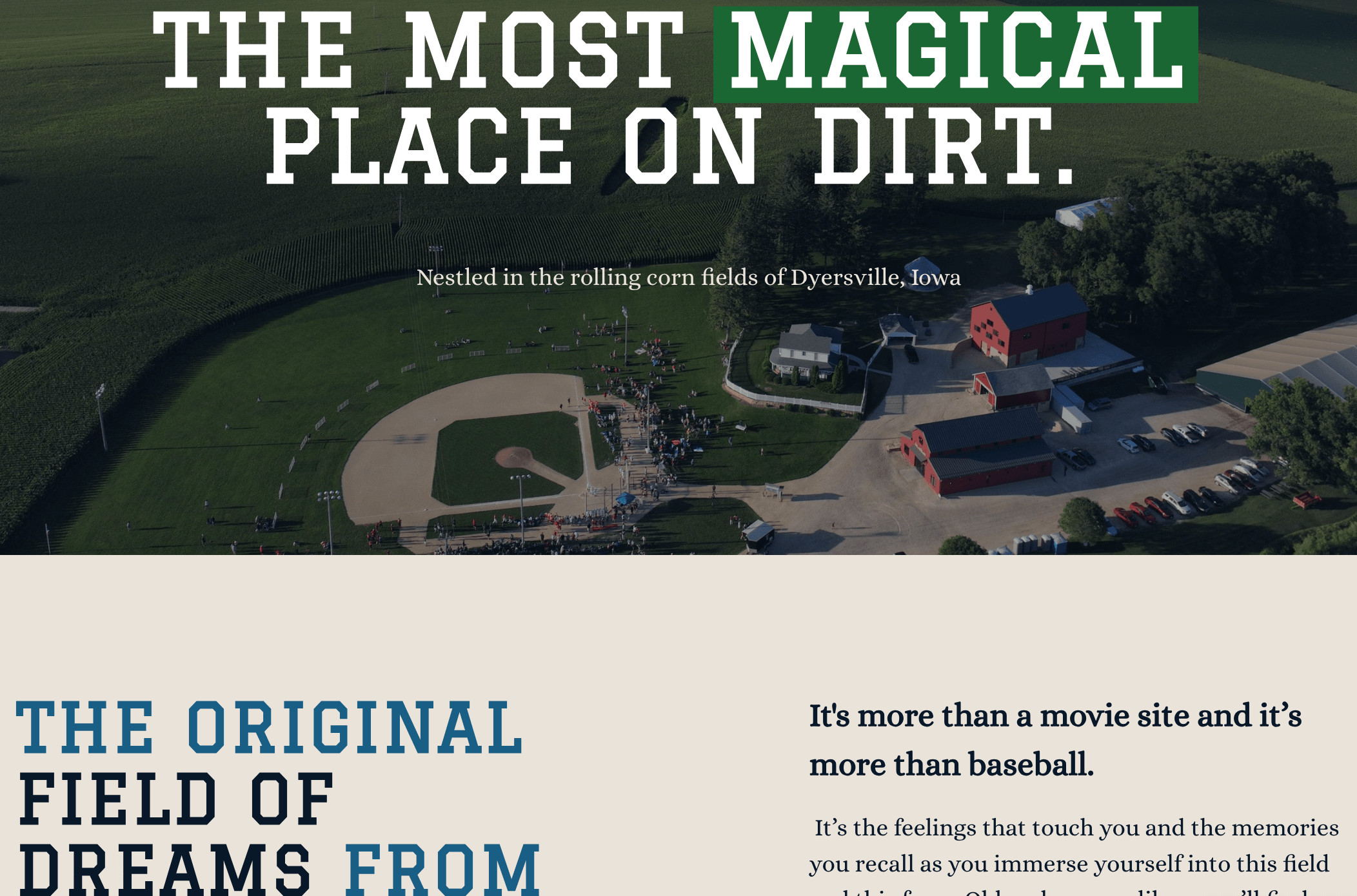 Typography on Field of Dreams
Typography on Field of Dreams
21. How Can Tourism Web Design Support Multiple Languages?
Tourism web design can support multiple languages by using a language selector, providing translated content, optimizing for different character sets, and ensuring proper text direction. SIXT.VN helps businesses create multilingual websites to cater to international audiences.
- Language Selector: Use a language selector that allows visitors to choose their preferred language.
- Translated Content: Provide translated content for all pages on your website.
- Character Sets: Optimize for different character sets to ensure that all characters are displayed correctly.
- Text Direction: Ensure that text direction is correct for different languages (e.g., right-to-left for Arabic).
- Cultural Sensitivity: Ensure that your translations are culturally sensitive and avoid any content that may be offensive to international audiences.
- SEO: Optimize your website for search engines in different languages by using hreflang tags.
22. What Role Does Branding Play in Tourism Web Design?
Branding plays a crucial role in tourism web design by creating a consistent and recognizable identity for your destination. A strong brand helps differentiate you from competitors and build trust with potential visitors.
- Visual Identity: Use consistent colors, fonts, and imagery to create a strong visual identity for your destination.
- Logo: Use a professional logo that represents your destination and is easily recognizable.
- Brand Voice: Use a consistent brand voice in all of your website content.
- Brand Values: Communicate your brand values clearly and consistently.
- Storytelling: Use storytelling to connect with visitors on an emotional level and create a memorable brand experience.
- Consistency: Ensure that your branding is consistent across all channels, including your website, social media, and marketing materials.
 Scrolling through Colonial Williamsburg website
Scrolling through Colonial Williamsburg website
23. How Can Tourism Web Design Be Used to Promote Sustainable Tourism Practices?
Tourism web design can promote sustainable tourism practices by highlighting eco-friendly activities, showcasing local communities, providing responsible travel tips, and partnering with sustainable businesses. SIXT.VN helps businesses promote sustainable practices to attract environmentally conscious travelers.
- Eco-Friendly Activities: Highlight eco-friendly activities, such as hiking, biking, and kayaking.
- Local Communities: Showcase local communities and their traditions.
- Travel Tips: Provide responsible travel tips, such as reducing waste, conserving water, and respecting local cultures.
- Sustainable Businesses: Partner with sustainable businesses, such as eco-friendly hotels and restaurants.
- Certifications: Highlight sustainable certifications, such as LEED and Green Globe.
- Impact: Communicate the positive impact of sustainable tourism on the environment and local communities.
24. What Are the Best Practices for Securing a Tourism Website?
Best practices for securing a tourism website include using HTTPS, implementing a web application firewall (WAF), keeping software up to date, using strong passwords, and regularly backing up your website. SIXT.VN prioritizes website security to protect user data and maintain trust.
- HTTPS: Use HTTPS to encrypt all data transmitted between your website and visitors.
- WAF: Implement a web application firewall (WAF) to protect your website from common security threats.
- Software Updates: Keep your website software, including your CMS, plugins, and themes, up to date.
- Strong Passwords: Use strong passwords for all accounts and change them regularly.
- Backups: Regularly back up your website to protect against data loss.
- Security Audits: Conduct regular security audits to identify and address potential vulnerabilities.
- Privacy Policy: Have a clear and comprehensive privacy policy that outlines how you collect, use, and protect visitor data.
25. How Can SIXT.VN Help with Best Tourism Web Design for Attracting Travelers to Vietnam?
SIXT.VN can help with best tourism web design by providing expert consultation, custom web design, SEO optimization, mobile responsiveness, and ongoing support. We are dedicated to crafting websites that capture the essence of Vietnam and attract travelers.
- Expert Consultation: We provide expert consultation to help you define your goals and develop a strategy for your tourism website.
- Custom Web Design: We create custom web designs that are tailored to your specific needs and brand.
- SEO Optimization: We optimize your website for search engines to help you attract more organic traffic.
- Mobile Responsiveness: We ensure that your website is fully responsive and provides a seamless experience on all devices.
- Ongoing Support: We provide ongoing support to ensure that your website remains secure, up-to-date, and effective.
SIXT.VN is your trusted partner for creating exceptional tourism web designs that capture the beauty of Vietnam and attract international visitors. Contact us today to learn more about how we can help you achieve your goals. Address: 260 Cau Giay, Hanoi, Vietnam. Hotline/Whatsapp: +84 986 244 358. Website: SIXT.VN.
Feeling inspired by these tourism website design examples?
Now that you’ve explored various tourism website designs, it’s time to start building your own! If you’re unsure how to execute your design to achieve the website you desire, the experts at SIXT.VN can assist you.
With years of experience in web design for the tourism sector, we understand how to craft websites that help you boost bookings and create memorable experiences. We focus on understanding the intent of the tourist, providing solutions, and inspiring them to take action.
Ready to build your dream website? Contact us online or call us today to speak with a strategist about our web design services!
Frequently Asked Questions (FAQ) About Tourism Web Design
- What is tourism web design? Tourism web design is the process of creating a website specifically tailored to promote a tourist destination, attraction, or service.
- Why is tourism web design important? It’s important because it serves as the first point of contact for potential visitors, influencing their decision to visit a destination or use a service.
- What are the key elements of effective tourism web design? Key elements include high-quality visuals, clear navigation, mobile responsiveness, compelling content, and strong call-to-action buttons.
- How can I ensure my tourism website is SEO-friendly? Ensure SEO-friendliness by conducting keyword research, optimizing content, ensuring mobile-friendliness, and building high-quality backlinks.
- How can I integrate social media into my tourism website? Integrate social media by adding social sharing buttons, embedding social feeds, and running social media campaigns.
- What role does mobile responsiveness play in tourism web design? Mobile responsiveness is essential because a significant portion of travelers use mobile devices to research and book their trips.
- How can I improve the loading speed of my tourism website? Improve loading speed by optimizing images, using browser caching, minimizing HTTP requests, and using a content delivery network (CDN).
- How can I cater to international audiences with my tourism website? Cater to international audiences by offering multilingual support, providing localized content, and accepting multiple currencies.
- How can I make my tourism website accessible? Make your website accessible by following accessibility standards such as WCAG and ensuring compatibility with assistive technologies.
- How can SIXT.VN help with my tourism web design needs? SIXT.VN offers expert consultation, custom web design, SEO optimization, mobile responsiveness, and ongoing support to help you create a website that attracts travelers and drives bookings.



